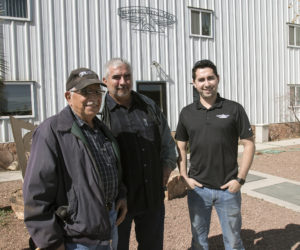Sisneros Brothers Manufacturing embodies the entrepreneurial notion that finding the right niche can transform talent into business success.
Avenicio Sisneros, founder of the Belen company, began as a cabinetmaker in the 1950s but shifted to making and installing sheet metal ducting for houses in 1987. With him were sons Martin, Alex and Philip.
Demand quickly grew beyond the residential market, and the company began manufacturing and installing ductwork for larger commercial customers. By 1990, Sisneros Brothers abandoned installation altogether to focus on manufacturing custom sheet metal ductwork for a wide variety of customers.
In 2001, the Sisneros leadership team consulted the New Mexico Manufacturing Extension Partnership (NM MEP) to get ideas about streamlining production and eliminating inefficiencies. The nonprofit organization helps businesses increase profitability and competitiveness, transforming them into lean and efficient engines of growth.

Sisneros Brothers’ founder Avenicio, left, son and CEO Martin, and grandson and sales manager Andres; photo by Jane Phillips
The results of NM MEP-inspired changes impressed company principals, and Sisneros Brothers returned to NM MEP a decade later when CEO Martin Sisneros decided it was time to grow and diversify the customer base.
Sisneros remembers his first impression when Andrea Holling, innovation director for NM MEP, appeared to tour the facility. “She showed up wearing high heels and I thought, ‘What does she know about manufacturing?’ ”
But once the tour was over and Holling presented company leaders with numerous ideas for eliminating production wrinkles, Sisneros respected that Holling knew her business. Without pushing any particular process, she pointed out critical bottlenecks and explained how to improve the flow of materials through fabrication.
Through collaboration with NM MEP, a core piece of machinery, the plasma welder, was identified as a source of slowdowns. The machine cuts and shapes sheet metal pieces to order, but it was too slow for the company’s needs. Sisneros Brothers decided to buy a faster machine and adjust related processes in preparation for picking up the pace when the new machine comes online.
To help workers keep track of faster-moving pieces, managers decided to attach a sticker to each molded segment with a diagram that shows what the finished part will look like.
NM MEP also helped the company reconfigure the production line to shorten the path from start to finish (some parts were moving up to 6 miles across the 55,000-square-foot plant during fabrication). Getting power to each machine in its new place required installation of an electrical system that spans the factory floor.
This improvement has built-in flexibility, with junction boxes at critical intervals and flexible tubing, so machines can be reorganized as needed to meet the changing demands of increased sales to international customers and to big clients, like the U.S. Navy.
As a result of the most recent NM MEP intervention, Sisneros said, “We’ve been able to increase our lead times and our production, and now we’re looking for new opportunities. We’re not just looking in the local or national economy. We’re looking worldwide.”
The company has created 35 local jobs, and Sisneros said policymakers who advocate U.S. manufacturing should support programs like NM MEP that stimulate the creation of domestic jobs and industries that are globally competitive.
To reach an NM MEP consultant, visit newmexicomep.org.
Download 498_Continuous Improvement Helps Belen Manufacturer Go Global PDF

